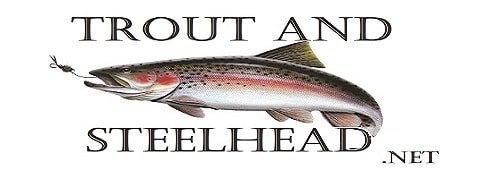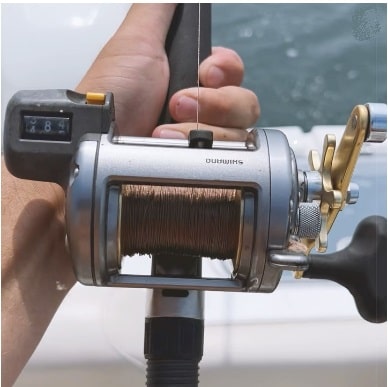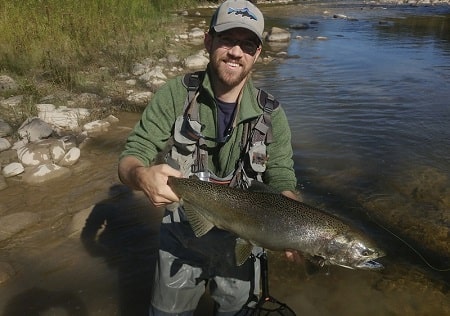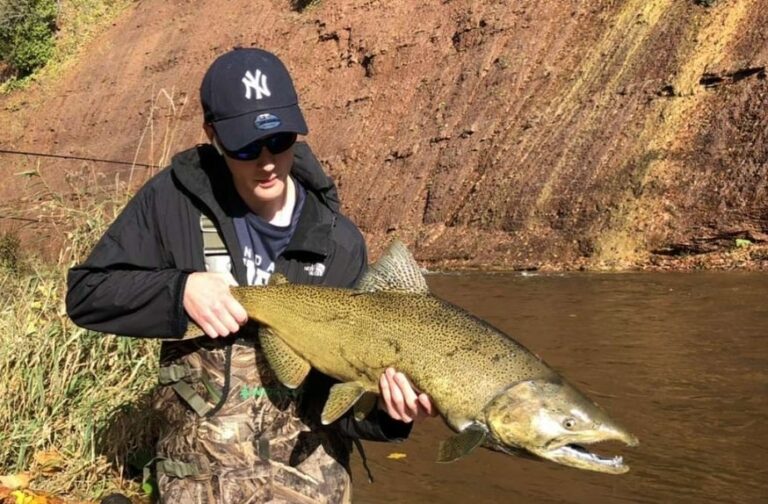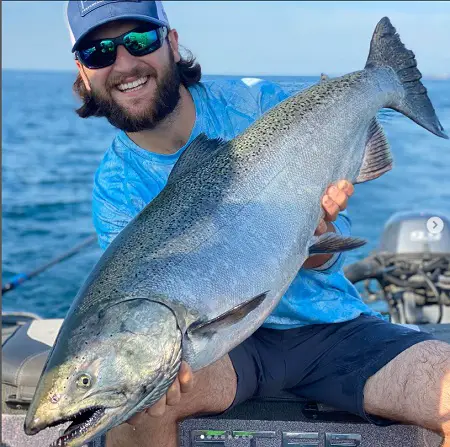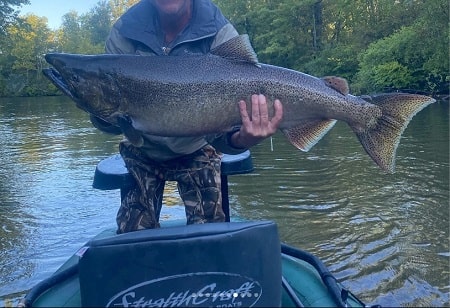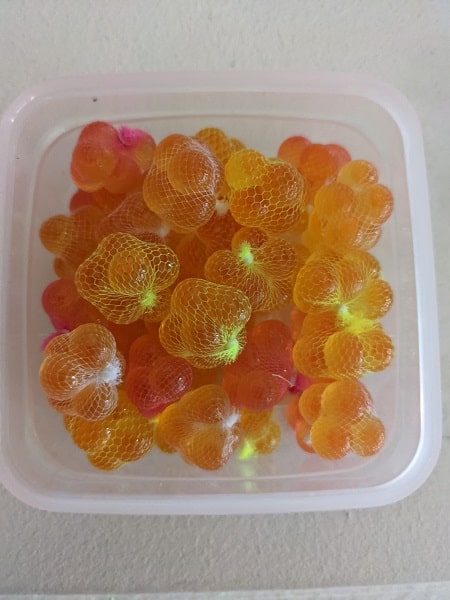Salmon Fishing In Ontario: A Complete Guide
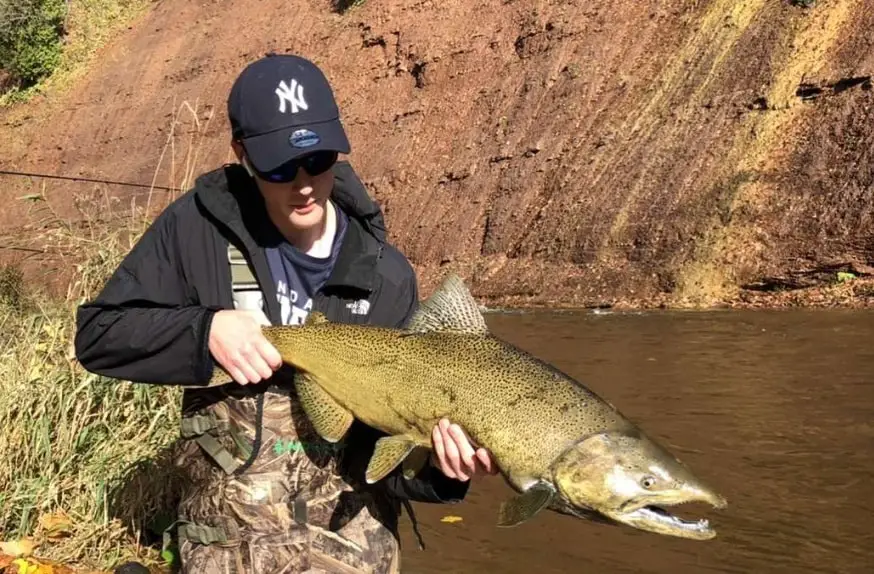
I have been a salmon guide in Ontario for 22 years, but I caught my first salmon over 37 years ago when I fell in love with salmon fishing in Ontario.
I still remember the glory days when salmon would come up the river by the thousands when fishing for Ontario salmon was at its peak. Great salmon fishing still happens today, but with more angling pressure, warm falls, and fewer salmon, it takes a little more knowledge and skill to have big number days.
I’ll share the methods I teach and use to help my clients catch more Ontario salmon.
About Ontario Salmon Fishing
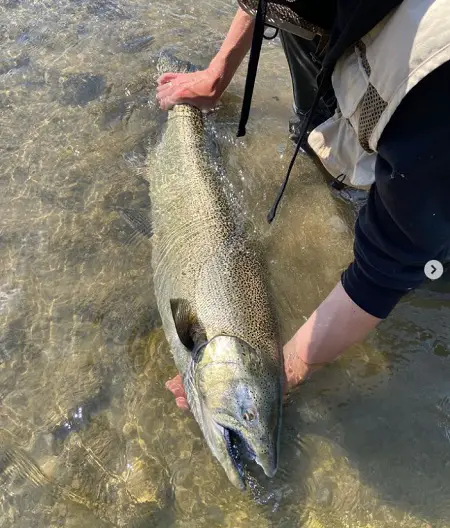
Southern Ontario is blessed with some of the best salmon rivers in the great lakes region. I have had days where I’ve hooked over 60 mature salmon over 20 pounds, with some pushing or over 40 pounds.
Ontario’s anglers can catch salmon in the great lakes or in the river when they return to spawn in the fall.
Ontario also has hundreds of miles of shorelines with hundreds of rivers and streams.
Most salmon fishing is done in southern Ontario, primarily in Lake Ontario and Lake Huron.
There are also sporadic salmon runs in northern Georgian Bay, but they are very limited. If you are going to fish Northern Ontario for salmon, the best area is the St. Mary River.
When Are The Ontario Salmon Runs
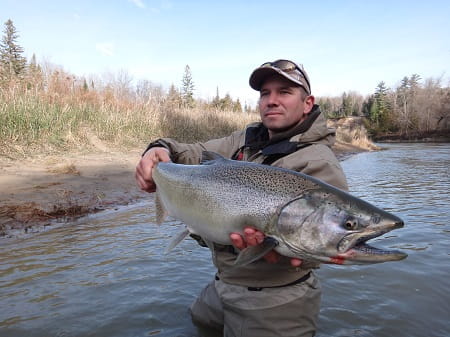
The salmon runs occur on some rivers starting in August. Yes, there are some rivers that, under the right conditions, will get runs of salmon in July, but these are few and far between, and the salmon get stressed out, so I’m not going to mention them here.
In general, the major salmon runs start after the first significant rains in September and then after each rain until around the beginning of November.
The Salmon Species of Ontario
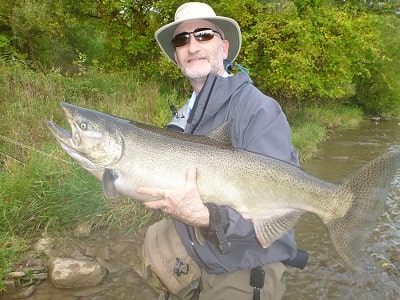
There are four salmon species available to Ontario anglers. The primary species are Chinook salmon and Coho salmon.
Chinook Salmon
Chinook salmon are also known as king salmon and they are the largest and most abundant salmon.
It’s not uncommon for boat anglers to limit out on huge lake salmon in a few hours or less.
River anglers can also hook 20 or more a day when the runs are thick. The average mature chinook salmon is around 25 pounds, with many over 35 pounds. See Fishing For King Salmon.
Coho Salmon
Coho salmon are smaller salmon, but they are known for their strength and fighting ability. They average around 10 pounds and fight like they are 20 pounds.
Atlantic Salmon
The new salmon on the block is the Atlantic salmon which is being reintroduced to Lake Ontario water by the Ontario and New York fisheries departments.
However, after tens of millions of stocked Atlantics, the numbers remain low when compared to stocking numbers of other species.
Pink Salmon
Pink salmon are rare and might be the result of natural reproduction from past stockings, or from roaming fish from other great lakes, but the pink salmon is almost never caught and are not in fishable numbers, with the exception of very far northern Lake Superior where Minnesota DNR stocks them. See Minnesota Salmon Fishing.
Do Ontario Salmon Eat When They Enter the River?
Growing up fishing these big salmon, I was told, and read that once salmon enter the river, their digestive system shuts down and they do not eat. This is pure BS.
I have seen salmon in the river swim across the river to smash a lure, a fly, and even grab my float.
Whatever their reason is for grabbing a bait, lure, or fly, they do! I also read a study done on the Salmon River in new york that confirmed that spawning salmon do in fact eat.
Ways To Fish Ontario Salmon
Anglers have three primary options for fishing for salmon in the lake or in the river.
Shore Fishing
Salmon anglers can take advantage of salmon that move in close to shore at certain times of the year. Casting lures from shore or casting out bait can be good ways to fish Ontario Salmon. When shore fishing for salmon you’ll need a long handle net, so be sure to check out the Best Salmon Nets article.
The top areas to fish from shore are river mouths, break walls, piers, points, harbors, and warm water outflows. See Shore Fishing For Salmon for more on the methods, the lures, and the baits, as well as the best times for shore fishing.
Boat Fishing
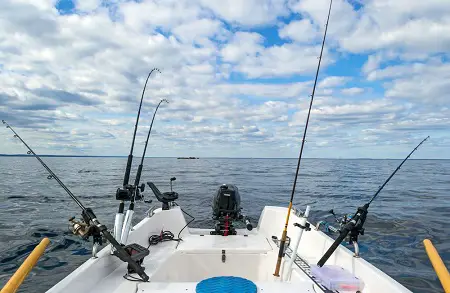
Boat fishing out in the lake starts in April, peaks in July and August, and continues until late fall.
Boat fishing consists primarily of trolling lures, plugs, cut baits, and flasher fly combinations.
The use of lead core lines, or downriggers, help get the lures down in the strike zone. See Trolling For Salmon article.
River Fishing

River fishing is where Ontario salmon fishing shines. Salmon will enter rivers in the fall by the tens of thousands on some river that provides world-class salmon fishing.
There are hundreds od streams that will get salmon wandering in to spawn. Although the majority of anglers fish in the larger, more well-known rivers, I have seen hundreds of salmon swim up creeks so small I could jump across them.
Now, I’m not saying go fish the little creeks, but when heavy rains flood these little creeks the salmon do get confused and some will enter these rivers.
Best Salmon Rivers In Ontario
I’m going to list the larger, more popular salmon rivers since listing every river I’ve heard salmon go in would take an entire article.
I’ll tell you this, just about every river and creek flowing into Lake Ontario will get some salmon if the creeks flood. Same with Souther Lake Huron and the South Shore of Georgian Bay.
Lake Ontario Salmon Rivers
The primary salmon rivers of Lake Ontario are:
- Ganaraska River
- Wilmot Creek
- Bowmanville Creek
- Duffins Creek
- Rouge River
- Humber River
- Credit River
- Bronte Creek
- Niagara River
Lake Huron Salmon Rivers
- 9 Mile Creek
- Bayfield River
- Mailand River
- Saugeen River
- Sauble River
Georgian Bay Salmon Rivers
- Sydenham River
- Bighead River
- Beaver River
- Nottawasaga River
- Coldwater River
Lake Erie Rivers
There are very few salmon in Lake Erie, so it’s not worth fishing for salmon in Lake Erie rivers. If there are salmon in these rivers, you are most likely to find them in:
- Grand River
- Big Creek
Some of these Ontario salmon streams are small and they can get very low and clear which can make it very difficult to catch the salmon. Check out Low Clear Water Salmon Fishing Tips and Tactics.
Best Time To Fish Ontario Salmon
There are different times that are best to fish Ontario salmon and it depends on the type of fishing you want to do.
April and May: April and may have good salmon fishing on the south end of Lake Ontario early in the spring. Salmon migrate to this area where the lake is likely the warmest and has the most baitfish. The areas around St Catherines and Niagara on The Lake are hotspots. These times can be good for shore and boat anglers.
June, July, August: The best mid-lake fishing occurs in late June to late August. Big numbers of easy to predict and find salmon are caught in July and August.
Large salmon will also start showing up at river mouths and closer to shore in late August.
September to November: The best shore and river fishing starts after the first big rain in August and can continue on some rivers until mid-November, with peak fishing being late September to late October.
NOTE: Many Ontario salmon rivers are closed to fishing on October 1st. However, there are extended fall sections and year-round sections available.
Best Fishing Methods For River Fishing Ontario Salmon
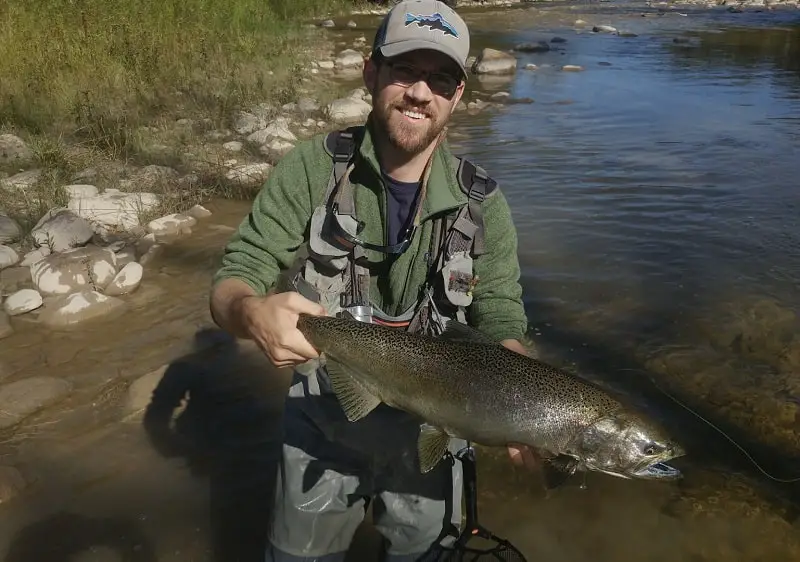
There are many ways to catch salmon once they enter the rivers.
Float Fishing
Float fishing for salmon is simply drifting your bait below a float along with the current. Use a good float designed for river fishing. Float fishing is best done in rivers that are 3 feet deep or more.
Lure Fishing
Casting lures at the river mouths or up in the river can be a great way to catch salmon. Use lures like spinners, spoons, and crankbaits. If this method appeals to you, check my article on Lure Fishing For Salmon.
Centerpin Fishing
Float fishing with a special reel known as a Centerpin reel is known in Ontario as Centerpin fishing. In my experience, Centerpin fishing for salmon s the most effective way to present a bait under a float and if done well, it is likely to catch you the most fish.
Fly Fishing
Fly fishing is my preferred method to fish most Ontario salmon rivers. Anglers can fly fish for salmon by casting streamers, or by drifting nymphs under an indicator, or spey fishing.
Brightly colored flies tend to do best, with egg flies being the most common fly. See the article Best Flies For Salmon for over 40 salmon flies.
Drift Fishing And Bottom Bouncing
Drift fishing in larger and deeper rivers is a good way to present your bait without the use of a float. I use this on rivers where I need to cast and fish far or fish deep. Check out my article, Drift Fishing For Salmon.
Bottom bouncing is a better method for close fishing, smaller sections of river, and pocket water. This is my most effective way of fishing for salmon in water under 3 feet deep.
Plunking For Salmon
Plunking is a still fishing bait method used in rivers or from shore. The angler casts out a heavy weight that anchors the bait near the bottom. This is a good method for catching cruising deep salmon. See the Plunking For Salmon article.
Jig Fishing
Anglers will also use jigs to catch salmon. Jigs can be drifted under a float, or an exciting way to fish is twitching jigs for salmon.
Best Baits For Ontario Salmon
I use the same bait for Ontario salmon that I do all around the Great Lakes. Baits like spawn sacs, Skein, worms both live and plastic worms, minnows, and artificial flies are all great options.
There are a bunch of other baits that can work as well. See my article 11 Best Baits For Salmon Fishing.
Salmon Fishing In Ontario Q&A
If you have any questions or would like to share your tips and advice on salmon fishing in Ontario, let us know in the comments section.
Tight Lines,
Graham
